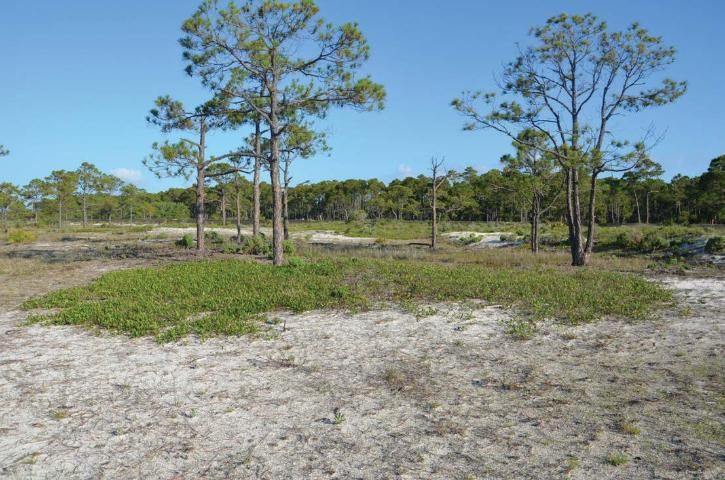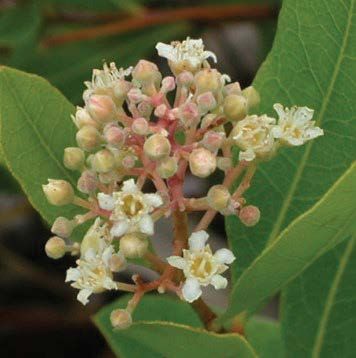Gopher Apple, Geobalanus oblongifolius Synonym: Licania michauxii
Note: This fact sheet is also available as a chapter in a comprehensive manual titled Dune Restoration and Enhancement for the Florida Panhandle, available in pdf form here: https://edis.ifas.ufl.edu/pdffiles/SG/SG15600.pdf. Please see the manual for more information about other useful and attractive native plants for dunes and for further information about restoration and preservation techniques.
Chrysobalanaceae

Credit: Gabriel Campbell, UF/IFAS
Gopher apple occurs from the lower Florida peninsula northward to South Carolina westward to Louisiana in coastal dunes, sandhills, and disturbed areas such as roadsides. Gopher apple gets its name because gopher tortoises, along with other small mammals, eat their fruit. Gopher apple is an ideal groundcover for a coastal landscape with well-draining soil and a low pH (Gilman 2014).
General Description
Gopher apple is a low-growing, clonal, evergreen shrub reaching heights of less than 1.6 ft that spreads via stout underground stems. Leaves are alternate, simple, elliptic to spatulate, and grow from 0.8 to 4 in long by 0.4 to 1.6 in wide. They are largest at midstem compared to upper and lower stem, glabrous or pubescent below, with shallowly undulate to entire margins. Leaves superficially resemble the leaves of oaks. Stems are stout, woody, underground, and give rise to aerial shoots. Flowers are white, borne in terminal clusters, and commonly extend past the leaves. They are inconspicuous and appear from April to summer.

Credit: Mack Thetford, UF/IFAS
Fruits are single-seeded drupes. They are fleshy, ellipsoid, dark purple to yellow (rarely white), and 0.4 to 1.6 in in diameter. Plants with reddish new growth typically produce purple fruits while plants with greenish-white new growth typically produce yellow to white fruits.
Propagation
Gopher apple seeds are not dormant and can be easily used for propagation with nearly 100% germination of viable seed (Wilson et al. 2010). Gopher apple prefers warmer alternating temperatures (30/20 and 35/25°C vs 25/15 and 20/10°C) when exposed to a 12-hour photoperiod (Wilson et al. 2010). Seedlings have performed well in a peat-based potting mix (Fafard 3B) when grown in a greenhouse (Smith et al. 2014).

Credit: Mack Thetford, UF/IFAS
Cutting propagation (softwood cuttings) of gopher apple is possible without the application of auxins, but auxins may increase rooting percentage to near 100% (Wilson, Pérez and Thetford, 2010). Cuttings may be taken in May or June before stems become woody. Place cuttings under intermittent mist with natural photoperiods.
Rooted cuttings failed to overwinter when new growth was not present before winter dormancy. More information on subsequent growth of rooting cuttings is needed.
Outplanting
Transplanting gopher apple is known to be difficult in the wild, but it should establish from nursery-grown plants (Gilman, 2014). Greenhouse-grown plants have been successfully grown in field plots in western and south Florida during a 10-month research trial (Smith et al. 2014).
Literature Cited
Gilman, E.F. 2014. Licania michauxii Gopher Apple. FPS-342. Gainesville: University of Florida Institute of Food and Agricultural Sciences. https://edis.ifas.ufl.edu/fp342
Smith, A.M., S.B. Wilson, M. Thetford, K.L. Nolan, and C. Reinhardt Adams. 2014. "Performance of nine Florida native wildflower species grown in varying container substrates." Native Plants Journal 15(1):75–86.
Wilson, S.B., H. Perez, and M. Thetford. 2010. Propagation, Production, and Landscape Evaluation of Native Wildflowers in West, Central and South Florida. Condensed Progress Report for the Florida Wildflower Foundation. https://www.flawildflowers.org/wp-content/resources/pdfs/Research/Wildflower%20year-end%20progress%20report-Wilson%20et%20al.pdf


